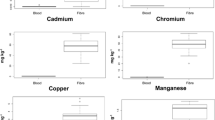Abstract
This study was performed with the aim of investigating the concentration of zinc and copper in the blood of healthy alpacas (Vicugna pacos) kept in central Europe and to compare the concentration of Zn and Cu in plasma and in whole blood. A further objective was to evaluate blood Zn and Cu in relation to different micromineral supplementation, age and sex groups of alpacas. A total of 299 alpacas (224 adults and 75 crias) from 18 farms were included in this study. The concentrations of copper and zinc in plasma/whole blood were measured by flame atomic absorption spectrometry. The results of this study show high individual variability in plasma Zn (median 3.54, range 1.56–8.01 μmol/l), whole blood Zn (median 10.01, range 6.23–75.0 μmol/l), plasma Cu (median 7.53, range 2.93–16.41 μmol/l) and whole blood Cu (median 6.33, range 3.02–13.95 μmol/l). Plasma Zn was not significantly influenced by sex, age or feeding group. Whole blood Zn was only significantly higher in females than in males. The intake of Zn in all groups was equal to or higher than the nutritional recommendation. During excessive supplementation, Zn absorption decreased and thus blood Zn did not reflect the higher intake. Only a weak correlation was found (Spearman correlation coefficient r = 0.384; p > 0.01; n = 204) between plasma and whole blood Zn concentrations. Plasma copper concentration was significantly influenced by age, sex and feeding; whole blood Cu by age and feeding. However, neither plasma Cu nor whole blood Cu reflected the intake of the element. We found a close correlation between plasma and blood copper concentrations (Spearman correlation coefficient r = 0.9043; p ≤ 0.01; n = 99). According to our results, copper in plasma or blood is not a good indicator of copper intake.




Similar content being viewed by others
References
Van Saun RJ (2006a) Nutrient requirements of South American camelids: a factorial approach. Small Rumin Res 61:165–186
National Research Council (1996) Nutrient requirements of beef cattle, seventh revised ed. National Academy Press, Washington, 242 p
National Research Council (1985) Nutrient requirements of sheep, sixth revised ed. National Academy Press, Washington, 99 pp
National Research Council (1981) Nutrient requirements of goats: angora, dairy and meat goats in temperate and tropical countries. National Academy Press, Washington, 91 pp
Van Saun RJ (2009a) Nutritional requirements and assessing nutritional status in camelids. Vet. Clin. North. Am. Food Anim. Pract. 25:265–279
Suttle NF (2010) Mineral nutrition of livestock, 4th edn. CAB International, Cambridge, 587 pp
Andrews AH, Cox A (1997) Suspected nutritional deficiency causing anaemia in llamas (Lama glama). Vet Rec 140:153–154
Palmer AC, Blakemore WF, O’Sullivan B, Ashton DG, Scott WA (1980) Ataxia and spinal cord degeneration in llama, wildebeest and camel. Vet. Rec. 107:10–11
Morgan KL (1992) Ataxia and head tremor in an alpaca (Lama pacos). Vet Rec 131:216–217
Junge RE, Thornburg L (1989) Copper poisoning in four llamas. J Am Vet Med Assoc 195:987–989
Carmalt JL, Baptiste KE, Blakley B (2001) Suspect copper toxicity in alpaca. Ca Vet J 42:554–556
Van Saun RJ (2006b) Nutritional diseases of South American camelids. Small Rumin Res 61:153–164
Van Saun RJ (2009b) Nutritional diseases of llamas and alpacas. Vet. Clin. North. Am. Food Anim. Pract. 25:797–810
Cebra C, Anderson DE, Tibary A, Van Saun RJ, Johnson LW (2014) Llama and alpaca care: medicine, surgery, reproduction, nutrition and herd health, 1st edn. Elsevier, St. Louis, 789 p
Scott DW, Vogel JW, Fleis RI, Miller WH, Smith MC (2010) Skin diseases in the alpaca (Vicugna pacos): a literature review and retrospective analysis of 68 cases (Cornell University 1997 – 2006). Vet Dermatology 22:2–16
Clauss M, Lendl CE, Schramel P, Streich WJ (2004) Skin lesions in alpacas and llamas with low zinc and copper status—a preliminary report. Vet J 167(3):302–305
Johnson LW (1989) Nutrition. Vet. Clin. North. Am. Food Anim. Pract. 5:37–54
Bechert US, Smith BB (1996) Serum macro and micro element concentrations in the llama. Vet Clin Nutr 3:119–127
Hoffman E (2006) The complete alpaca book, 2nd edn. Bonny Doon Press, Santa Cruz, 620 p
Husakova T, Pavlata L, Pechova A, Hauptmanova K, Tichy L (2014) Assessment of selenium status in alpaca. Small Rum Res 8(9):1448–1455
Fowler ME (1998) Feeding and nutrition. Medicine and surgery of South American camelids: llama, alpaca, vicuna, guanaco, 2nd edn. Iowa State University Press, Ames (IA), pp 12–48
Mohamed HE (2004) The zinc and copper content of the plasma of Sudanese camels (Camelus dromedaries). Vet Res Com 28:359–363
Herdt T, Hoff B (2011) The use of blood analysis to evaluate trace mineral status in ruminant livestock. Vet Clin North Am Food Anim Pract 27:255–283
Smith BB, Van Saun RJ, Reed PJ, Craig AM, Youngberg A (1998) Blood mineral and vitamin E concentrations in llamas. American Journal of Veterinary Research (AJVR) 59:1063–1070
Vitoux D, Arnaud J, Chappuis P (1999) Are copper, zinc and selenium in erythrocytes valuable biological indexes of nutrition and pathology? J Trace Elements Med Biol 13:113–128
Grace NG, Hill FI, Death AF, Wyeth TK (1994) A preliminary study of copper supplementation in alpacas (Lama-pacos). N Z Vet J 42:114–116
Foster A, Bidewell C, Barnett J, Sayers R (2009) Haematology and biochemistry in alpacas and llamas. 31:276–281
Ellison R (2009) Trace minerals. Vet Scholar online learning course. VetLearn Foundation, New Zealand Veterinary Association, Module 2, Topic 1, 1–8
López-Alonso M, Crespo A, Miranda M, Castillo C, Hernandez J, Benedito JL (2006) Assessment of some blood parameters as potential markers of hepatic copper accumulation in cattle. J Vet Diagn Investig 18:71–75
Acknowledgements
This research was made possible by research project MSM6215712403 of the Ministry of Education, Youth and Sports of the Czech Republic and by grant 43/2012/FVL of IGA of the University of Veterinary and Pharmaceutical Sciences Brno.
Author information
Authors and Affiliations
Corresponding author
Rights and permissions
About this article
Cite this article
Pechová, A., Husáková, T., Pavlata, L. et al. Assessment of the Zinc and Copper Status in Alpaca. Biol Trace Elem Res 181, 242–250 (2018). https://doi.org/10.1007/s12011-017-1043-x
Received:
Accepted:
Published:
Issue Date:
DOI: https://doi.org/10.1007/s12011-017-1043-x




